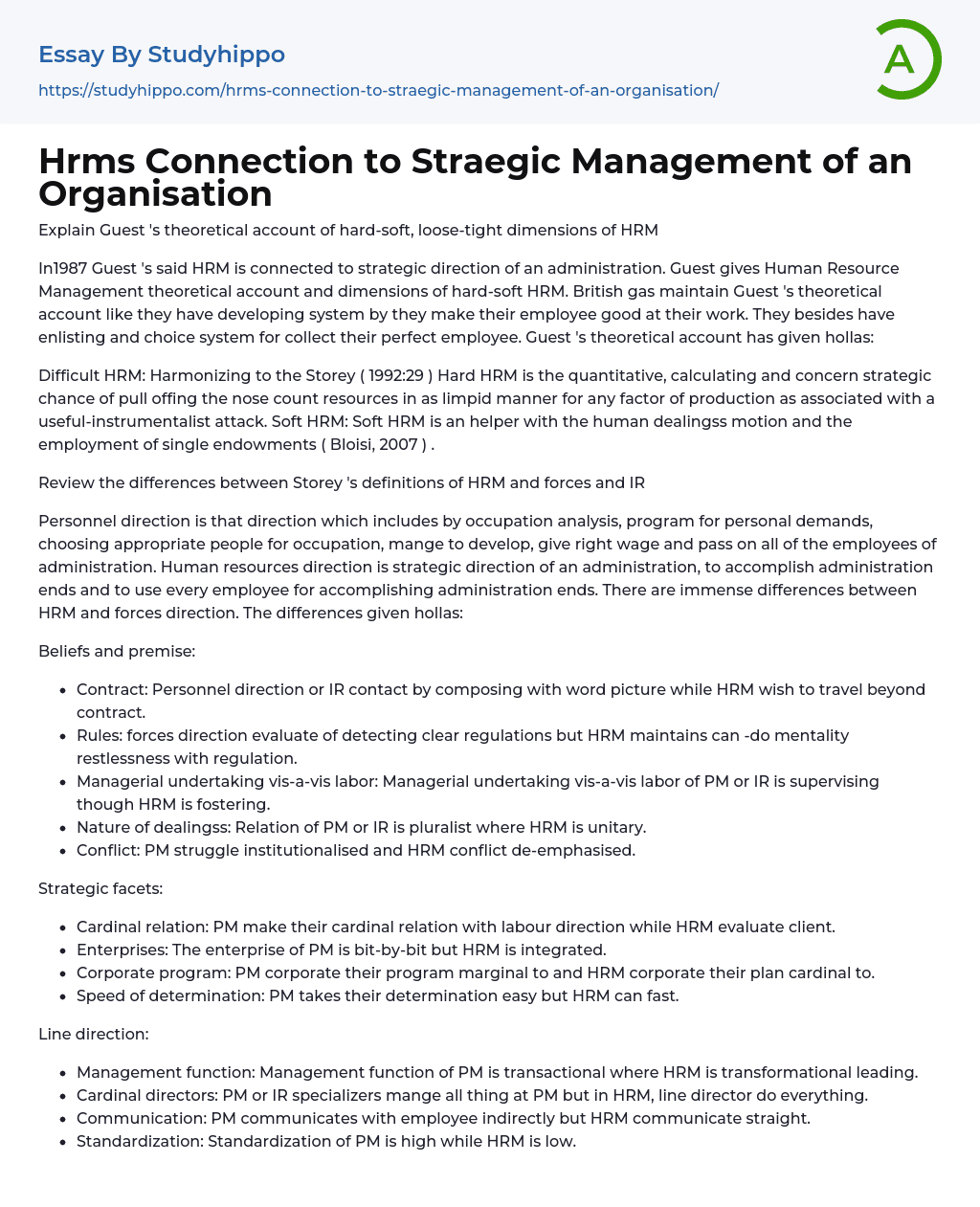

Hrms Connection to Straegic Management of an Organisation Essay Example
Guest's theoretical account of hard-soft, loose-tight dimensions of HRM is explained.
In 1987, Guest argued that HRM is closely linked to an organization's strategic management. Guest proposed a theoretical model for Human Resource Management, which encompasses the hard-soft dimensions of HRM. British Gas adopts Guest's model by implementing a training system to enhance employee skills, as well as an effective recruitment and selection system to attract the best candidates. Guest's model can be categorized into two dimensions: Hard HRM, defined by Storey (1992:29) as a quantitative, calculative and strategically-driven approach to managing human resources with a focus on maximizing efficiency.
Soft HRM, also known as helper with the human relations motion and the employment of individual talents, is a concept discussed by Bloisi (2007). This concept emphasizes the differences between Storey's definitions of HRM and personnel/indus
...trial relations (IR). Personnel management involves job analysis, meeting personal needs, selecting suitable employees, managing development, providing fair compensation, and communicating with all employees within an organization. On the other hand, human resources management is the strategic management of an organization aimed at achieving organizational goals and utilizing every employee to reach those goals. HRM and personnel/IR have significant differences in beliefs and assumptions. In terms of contract, personnel/IR adhere to specific terms while HRM aims to go beyond these terms. Personnel/IR focus on observing clear rules, whereas HRM emphasizes a can-do attitude and flexibility towards rules. The managerial task in personnel/IR is mainly monitoring, while in HRM it focuses on fostering relationships. The nature of relations in personnel/IR is pluralist, whereas in HRM it is unitary. Conflict is institutionalized in personnel/IR while de-emphasized in HRM. From
a strategic standpoint, personnel/IR prioritize their relationship with labor management as their key relationship, whereas HRM emphasizes the evaluation of customers as their key relationship.
Line direction:
- Management function: PM's management function is transactional, whereas HRM's management function is transformational and guiding.
- Cardinal directors: PM or IR specialists manage everything in PM, but in HRM, line directors handle all tasks.
- Communication: PM communicates indirectly with employees, while HRM communicates directly.
- Standardization: PM's standardization is high, but HRM's standardization is low.
Cardinal levers:
- Choice: PM individually selects their employees, while HRM integrates the selection process.
- Wage: PM pays employees based on job rating, while HRM pays based on performance.
- Job classes: PM has various job classifications, but HRM has fewer.
- Job design: PM designs jobs through division of labor, but HRM designs jobs through teamwork (Bloisi, 2007).
Demonstrate that effective judgement has been made to establish the contribution of strategic HRM in achieving the corporate goalsThe role of the line director is to achieve the organization's goals and manage all tasks on behalf of the organization.
The HR department of British Gas plays a crucial role in the administration, as highlighted in my case study. The organization's ability to achieve its goals heavily relies on having an HR director. Among their responsibilities, the HR director is responsible for
planning, resourcing, and maintaining the workforce. The line managers depend on the HR director to have knowledge of the current staff count, identify staffing needs in various departments, and make decisions related to hiring or recruitment. For instance, at Sainsbury's, directors must hire additional staff during peak hours such as weekends when the store is busiest. They also need to assess which employees are suitable for operating specific systems. Using this information, the HR director can effectively plan how many employees to hire and determine the appropriate hiring process.
The planning and resourcing function is crucial for a line director, as is retention. Retention refers to the responsibility of the director in ensuring staff satisfaction and enrolling new employees when necessary.
Because new people do not know what their main duties and operating system are, the manager needs to inform everyone about their job. Additionally, the manager helps them become successful employees in order to achieve their goals. The director develops their new employees through training methods.
- Rewarding salary: Employees rely on their organization to sustain their livelihood. Therefore, the manager must provide fair and adequate payment.
Managers also need to implement
reward systems such as pensions and healthcare in order to satisfy employees and encourage them to work harder. This can lead to improved employee relations, which involves maintaining good behavior, being accessible and supportive, and showing an understanding of employees' personal lives (Bloisi, 2007).
- Performance essays
- Human Resources essays
- Recruitment essays
- Code of Ethics essays
- Organizational Behavior essays
- Dress Code essays
- Safety essays
- Conflict essays
- Qualities essays
- Leadership and Management essays
- Change Management essays
- Project Management essays
- Knowledge Management essays
- Operations Management essays
- Quality Management essays
- Risk Management essays
- Scientific Management essays
- supply chain management essays
- Performance Management essays
- Time Management essays
- Brand Management essays
- Total Quality Management essays
- Risk essays
- Manager essays
- Leadership essays
- Business Ethics essays
- Board Of Directors essays
- Product Management essays
- Comparative Analysis essays
- Decision Making essays
- Dispute Resolution essays
- Stress Management essays
- Business Management essays
- Brand Equity essays
- Branding essays
- Nike, Inc. essays
- Market share essays
- Razor essays
- Being A Leader essays
- Servant Leadership essays
- Leadership Experience essays
- Leadership Qualities essays
- Incentive essays
- Arranged Marriage essays
- Communication essays
- Conflict Management essays
- Conflict Resolution essays
- Connection essays
- Conversation essays
- Dating essays



